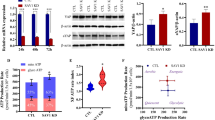Abstract
The role of nutrients and metabolism in cellular differentiation is poorly understood. Using RNAi screening, metabolic profiling and small-molecule probes, we discovered that the knockdown of three metabolic enzymes—phosphoglycerate kinase (Pgk1), hexose-6-phosphate dehydrogenase (H6pd) and ATP citrate lyase (Acl)—induces differentiation of mouse C2C12 myoblasts even in the presence of mitogens. These enzymes and the pathways they regulate provide new targets for the control of myogenic differentiation in myoblasts and rhabdomyosarcoma cells.
This is a preview of subscription content, access via your institution
Access options
Subscribe to this journal
Receive 12 print issues and online access
$259.00 per year
only $21.58 per issue
Buy this article
- Purchase on Springer Link
- Instant access to full article PDF
Prices may be subject to local taxes which are calculated during checkout


Similar content being viewed by others
References
Loh, Y.H., Ng, J.H. & Ng, H.H. Cell Cycle 7, 885–891 (2008).
Bolouri, H. & Davidson, E.H. Dev. Biol. 246, 2–13 (2002).
Yaffe, D. & Saxel, O. Differentiation 7, 159–166 (1977).
Popanda, O., Fox, G. & Thielmann, H.W. Biochim. Biophys. Acta 1397, 102–117 (1998).
Ozcan, U. et al. Science 313, 1137–1140 (2006).
Lavery, G.G. et al. J. Biol. Chem. 283, 8453–8461 (2008).
Nakanishi, K., Dohmae, N. & Morishima, N. FASEB J. 21, 2994–3003 (2007).
Tomida, T. et al. EMBO J. 22, 3825–3832 (2003).
Schulz, R.A. & Yutzey, K.E. Dev. Biol. 266, 1–16 (2004).
Rathmell, J.C. & Newgard, C.B. Science 324, 1021–1022 (2009).
Beigneux, A.P. et al. J. Biol. Chem. 10, 9557–9564 (2004).
Dagher, R. & Helman, L. Oncologist 4, 34–44 (1999).
Tomczak, K.K. et al. FASEB J. 18, 403–405 (2004).
Barash, V., Erlich, T. & Bashan, N. Biochem. Int. 20, 267–274 (1990).
Hewitt, K.N., Walker, E.A. & Stewart, P.M. Endocrinology 146, 2539–2543 (2005).
Hatzivassiliou, G. et al. Cancer Cell 8, 311–321 (2005).
Acknowledgements
We thank the RNAi Consortium for shRNAs and the following members of the RNAi platform of the Broad Institute for their scientific advising: A. Derr, J. Grenier, S. Silver, G. Cowley and O. Alkan. We also thank S. Carr, R. Wei, E. Yang and members of the Broad Institute metabolic profiling platform for scientific advice and analysis of metabolite extracts, and J. Nisbet of Children's Hospital Boston for thoughtful comments. This work was supported in part by US Department of Defense Breast Cancer Innovator Award #BC074986 (to D.E.I.) and US National Institute of General Medical Sciences grant 38627 (to S.L.S.). S.L.S. is an investigator with the Howard Hughes Medical Institute. A.L.B. was supported in part by the US National Science Foundation.
Author information
Authors and Affiliations
Contributions
A.L.B. designed and performed the RNAi screen, all validation experiments, quantitative RT-PCR, generation of stable cell lines and studies on cyclosporin, cholesterol and trichostatin. A.R. designed and performed metabolite experiments and the histone acetylation study. S.L.S. participated in the design of the overall study. S.H., D.E.I. and S.L.S. contributed to the preparation of the manuscript. D.E.I. and A.L.B. conceived of the idea for this study. All authors interpreted data, commented on results and participated in writing the manuscript.
Corresponding authors
Ethics declarations
Competing interests
The authors declare no competing financial interests.
Supplementary information
Supplementary Text and Figures
Supplementary Figures 1-3, Supplementary Tables 1 and 2, and Supplementary Methods (PDF 780 kb)
Rights and permissions
About this article
Cite this article
Bracha, A., Ramanathan, A., Huang, S. et al. Carbon metabolism–mediated myogenic differentiation. Nat Chem Biol 6, 202–204 (2010). https://doi.org/10.1038/nchembio.301
Received:
Accepted:
Published:
Issue Date:
DOI: https://doi.org/10.1038/nchembio.301
This article is cited by
-
Repair of airway epithelia requires metabolic rewiring towards fatty acid oxidation
Nature Communications (2023)
-
TRAIL/DR5 pathway promotes AKT phosphorylation, skeletal muscle differentiation, and glucose uptake
Cell Death & Disease (2021)
-
c-MYC Triggers Lipid Remodelling During Early Somatic Cell Reprogramming to Pluripotency
Stem Cell Reviews and Reports (2021)
-
Pro-myogenic small molecules revealed by a chemical screen on primary muscle stem cells
Skeletal Muscle (2020)
-
Targeting immunometabolism as an anti-inflammatory strategy
Cell Research (2020)



